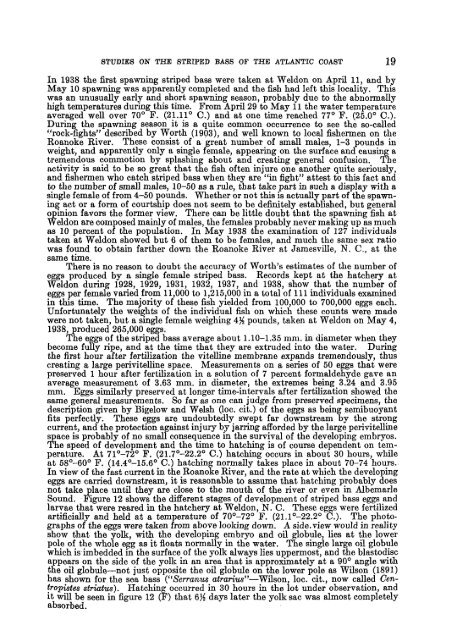Fishery bulletin of the Fish and Wildlife Service - NOAA
Fishery bulletin of the Fish and Wildlife Service - NOAA
Fishery bulletin of the Fish and Wildlife Service - NOAA
You also want an ePaper? Increase the reach of your titles
YUMPU automatically turns print PDFs into web optimized ePapers that Google loves.
STUDIES ON THE STRIPED BASS OF THE ATLANTIC COAST 19<br />
In 1938 <strong>the</strong> first spawning striped bass were taken at Weldon on April 11, <strong>and</strong> by<br />
May 10 spawning was apparently completed <strong>and</strong> <strong>the</strong> fish had left this locality. This<br />
was an unusually early <strong>and</strong> short spawning season, probably due to <strong>the</strong> abnormally<br />
high temperatures during this time. From April 29 to May 11 <strong>the</strong> water temperature<br />
averaged weU over 70° F. (21.11° C.) <strong>and</strong> at one tune reached 77° F. (25.0° C.).<br />
During <strong>the</strong> spawning season it is a quite common occurrence to see <strong>the</strong> so-called<br />
"rock-fights" described by Worth (1903), <strong>and</strong> well known to local fishermen on <strong>the</strong><br />
Roanoke River. These consist <strong>of</strong> a great number <strong>of</strong> small males, 1-3 pounds in<br />
weight, <strong>and</strong> apparently only a single female, appearing on <strong>the</strong> surface <strong>and</strong> causing a<br />
tremendous commotion by splashing about <strong>and</strong> creating general confusion. The<br />
activity is said to be so great that <strong>the</strong> fish <strong>of</strong>ten injure one ano<strong>the</strong>r quite seriously,<br />
<strong>and</strong> fishermen who catch striped bass when <strong>the</strong>y are "in fight" attest to this fact <strong>and</strong><br />
to <strong>the</strong> number <strong>of</strong> small males, 10-50 as a rule, that take part in such a display with a<br />
single female <strong>of</strong> from 4-50 pounds. Whe<strong>the</strong>r or not this is actually part <strong>of</strong> <strong>the</strong> spawning<br />
act or a form <strong>of</strong> courtship does not seem to be definitely established, but general<br />
opinion favors <strong>the</strong> former view. There can be little doubt that <strong>the</strong> spawning fish at<br />
Weldon are composed mainly <strong>of</strong> males, <strong>the</strong> females probably never making up as much<br />
as 10 percent <strong>of</strong> <strong>the</strong> population. In May 1938 <strong>the</strong> examination <strong>of</strong> 127 individuals<br />
taken at Weldon showed but 6 <strong>of</strong> <strong>the</strong>m to be females, <strong>and</strong> much <strong>the</strong> same sex ratio<br />
was found to obtain far<strong>the</strong>r down <strong>the</strong> Roanoke River at Jamesville, N. C., at <strong>the</strong><br />
same time.<br />
There is no reason to doubt <strong>the</strong> accuracy <strong>of</strong> Worth's estimates <strong>of</strong> <strong>the</strong> number <strong>of</strong><br />
eggs produced by a single female striped bass. Records kept at <strong>the</strong> hatchery at<br />
Weldon during 1928, 1929, 1931, 1932, 1937, <strong>and</strong> 1938, show that <strong>the</strong> number <strong>of</strong><br />
eggs per female varied from 11,000 to 1,215,000 in a total <strong>of</strong> 111 individuals examined<br />
in this time. The majority <strong>of</strong> <strong>the</strong>se fish yielded from 100,000 to 700,000 eggs each.<br />
Unfortunately <strong>the</strong> weights <strong>of</strong> <strong>the</strong> individual fish on which <strong>the</strong>se counts were made<br />
were not taken, but a single female weighing 4% pounds, taken at Weldon on May 4,<br />
1938, produced 265,000 eggs.<br />
The eggs <strong>of</strong> <strong>the</strong> striped bass average about 1.10-1.35 mm. in diameter when <strong>the</strong>y<br />
become fully ripe, <strong>and</strong> at <strong>the</strong> time that <strong>the</strong>y are extruded into <strong>the</strong> water. During<br />
<strong>the</strong> first hour after fertilization <strong>the</strong> vitelline membrane exp<strong>and</strong>s tremendously, thus<br />
creating a large perivitelline space. Measurements on a series <strong>of</strong> 50 eggs that were<br />
preserved 1 hour after fertilization in a solution <strong>of</strong> 7 percent formaldehyde gave an<br />
average measurement <strong>of</strong> 3.63 mm. in diameter, <strong>the</strong> extremes being 3.24 <strong>and</strong> 3.95<br />
mm. Eggs similarly preserved at longer time-intervals after fertilization showed <strong>the</strong><br />
same general measurements. So far as one can judge from preserved specimens, <strong>the</strong><br />
description given by Bigelow <strong>and</strong> Welsh (loc. cit.) <strong>of</strong> <strong>the</strong> eggs as being semibuoyant<br />
fits perfectly. These eggs are undoubtedly swept far downstream by <strong>the</strong> strong<br />
current, <strong>and</strong> <strong>the</strong> protection against injury by jarring afforded by <strong>the</strong> large perivitelline<br />
space is probably <strong>of</strong> no small consequence in <strong>the</strong> survival <strong>of</strong> <strong>the</strong> developing embryos.<br />
The speed <strong>of</strong> development <strong>and</strong> <strong>the</strong> time to hatching is <strong>of</strong> course dependent on temperature.<br />
At 71°-72° F. (21.7°-22.2° C.) hatching occurs in about 30 hours, while<br />
at 58°-60° F. (14.4°-15.6° C.) hatching normally takes place in about 70-74 hours.<br />
In view <strong>of</strong> <strong>the</strong> fast current in <strong>the</strong> Roanoke River, <strong>and</strong> <strong>the</strong> rate at which <strong>the</strong> developing<br />
eggs are carried downstream, it is reasonable to assume that hatching probably does<br />
not take place until <strong>the</strong>y are close to <strong>the</strong> mouth <strong>of</strong> <strong>the</strong> river or even in Albemarle<br />
Sound. Figure 12 shows <strong>the</strong> different stages <strong>of</strong> development <strong>of</strong> striped bass eggs <strong>and</strong><br />
larvae that were reared in <strong>the</strong> hatchery at Weldon, N. C. These eggs were fertilized<br />
artificially <strong>and</strong> held at a temperature <strong>of</strong> 70°-72° F. (21.1°-22.2° C.). The photographs<br />
<strong>of</strong> <strong>the</strong> eggs were taken from above looking down. A side, view would in reality<br />
show that <strong>the</strong> yolk, with <strong>the</strong> developing embryo <strong>and</strong> oil globule, lies at <strong>the</strong> lower<br />
pole <strong>of</strong> <strong>the</strong> whole egg as it floats normally in <strong>the</strong> water. The single large oil globule<br />
which is imbedded in <strong>the</strong> surface <strong>of</strong> <strong>the</strong> yolk always lies uppermost, <strong>and</strong> <strong>the</strong> blastodisc<br />
appears on <strong>the</strong> side <strong>of</strong> <strong>the</strong> yolk in an area that is approximately at a 90° angle with<br />
<strong>the</strong> oil globule—not just opposite <strong>the</strong> oil globule on <strong>the</strong> lower pole as Wilson (1891)<br />
has shown for <strong>the</strong> sea bass ("Serranus atrarius"—Wilson, loc. cit., now called Centropistes<br />
stríatus). Hatching occurred in 30 hours in <strong>the</strong> lot under observation, <strong>and</strong><br />
it will be seen in figure 12 (F) that 6% days later <strong>the</strong> yolk sac was almost completely<br />
absorbed.

















